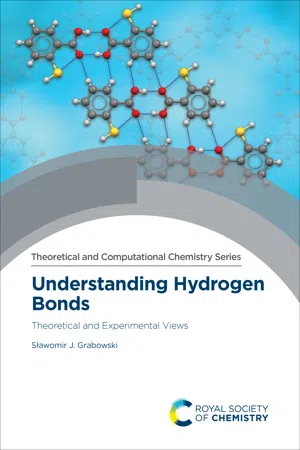
Understanding Hydrogen Bonds
Theoretical and Experimental Views
- 450 pages
- English
- ePUB (mobile friendly)
- Available on iOS & Android
Understanding Hydrogen Bonds
Theoretical and Experimental Views
About this book
Hydrogen bonded systems play an important role in all aspects of science but particularly chemistry and biology. Notably, the helical structure of DNA is heavily reliant on the hydrogens bonds between the DNA base pairs. Although the area of hydrogen bonding is one that is well established, our understanding has continued to develop as the power of both computational and experimental techniques has improved.
Understanding Hydrogen Bonds presents an up-to-date overview of our theoretical and experimental understanding of the hydrogen bond. Well-established and novel approaches are discussed, including quantum theory of 'atoms in molecules' (QTAIM); the electron localization function (ELF) method and Car–Parinnello molecular dynamics; the natural bond orbital (NBO) approach; and X-ray and neutron diffraction and spectroscopy. The mechanism of hydrogen bond formation is described and comparisons are made between hydrogen bonds and other types of interaction. The author also takes a look at new types of interaction that may be classified as hydrogen bonds with a focus on those with multicentre proton acceptors or with multicentre proton donors.
Understanding Hydrogen Bonds is a valuable reference for experimentalists and theoreticians interested in updating their understanding of the types of hydrogen bonds, their role in chemistry and biology, and how they can be studied.
Frequently asked questions
- Essential is ideal for learners and professionals who enjoy exploring a wide range of subjects. Access the Essential Library with 800,000+ trusted titles and best-sellers across business, personal growth, and the humanities. Includes unlimited reading time and Standard Read Aloud voice.
- Complete: Perfect for advanced learners and researchers needing full, unrestricted access. Unlock 1.4M+ books across hundreds of subjects, including academic and specialized titles. The Complete Plan also includes advanced features like Premium Read Aloud and Research Assistant.
Please note we cannot support devices running on iOS 13 and Android 7 or earlier. Learn more about using the app.
Information
1.1Definitions of Hydrogen Bond
Table of contents
- Cover
- Half Title
- Series Information
- Dedication
- Title Page
- Copyright Page
- Preface
- Contents
- Chapter 1 Hydrogen Bond – Definitions, Criteria of Existence and Various Types
- Chapter 2 Counterparts of the Hydrogen Bond
- Chapter 3 Theoretical Approaches
- Chapter 4 Experimental Methods and Techniques
- Chapter 5 Mechanisms of Hydrogen Bond Formation, Red-shifting and Blue-shifting Hydrogen Bonds
- Chapter 6 From Weak Interactions to Covalent Bonds: Weak, Moderate and Strong Hydrogen Bonds
- Chapter 7 Intramolecular Hydrogen Bonds
- Chapter 8 At The Border of Hydrogen Bond Definitions – Interactions Possessing Some of its Characteristics
- Chapter 9 Remarks and Conclusions
- Subject Index